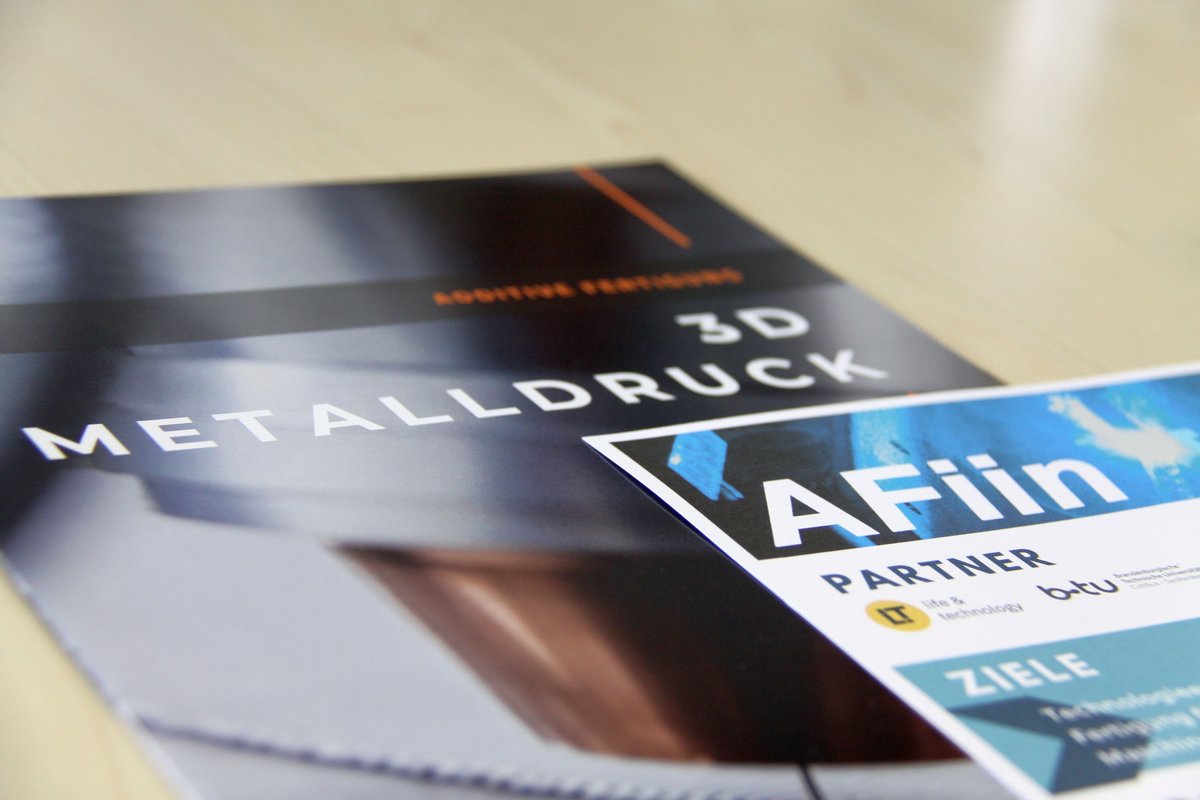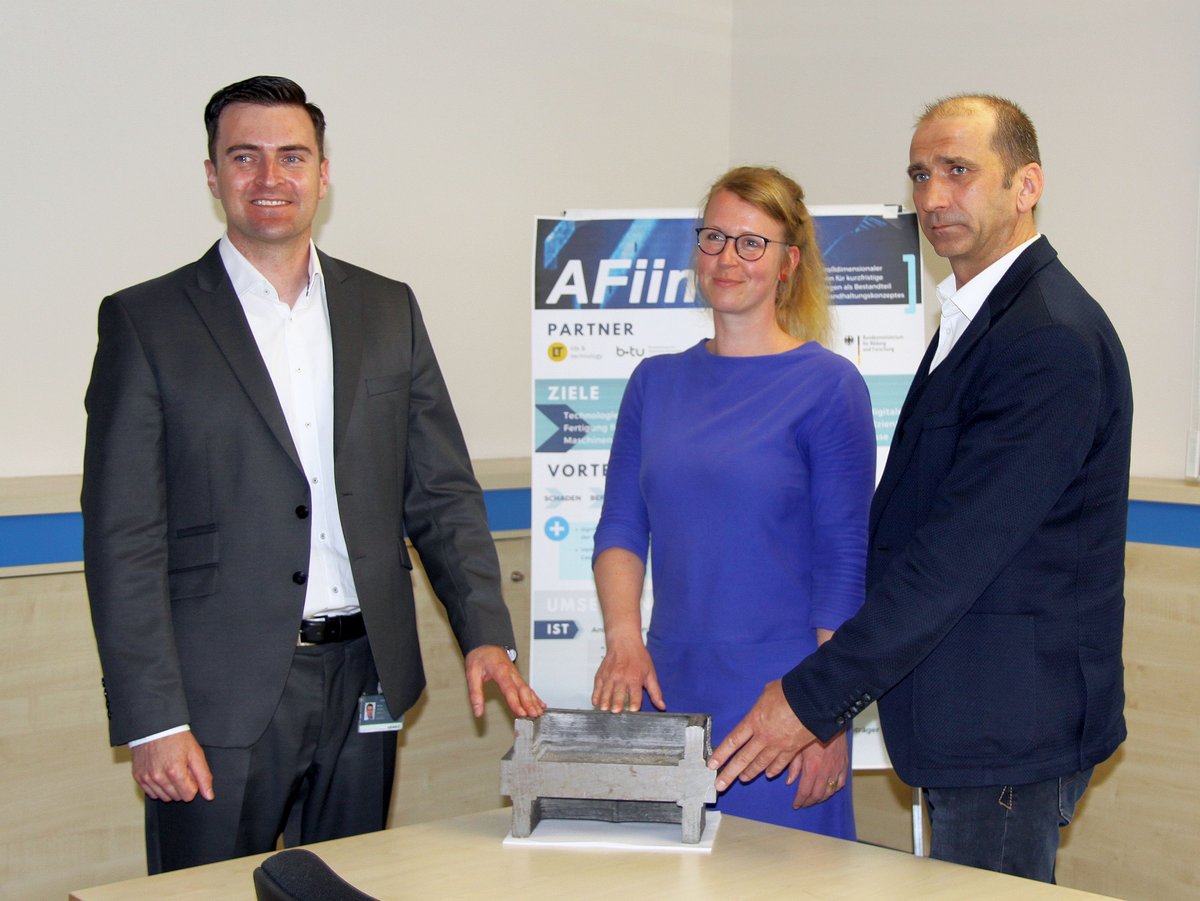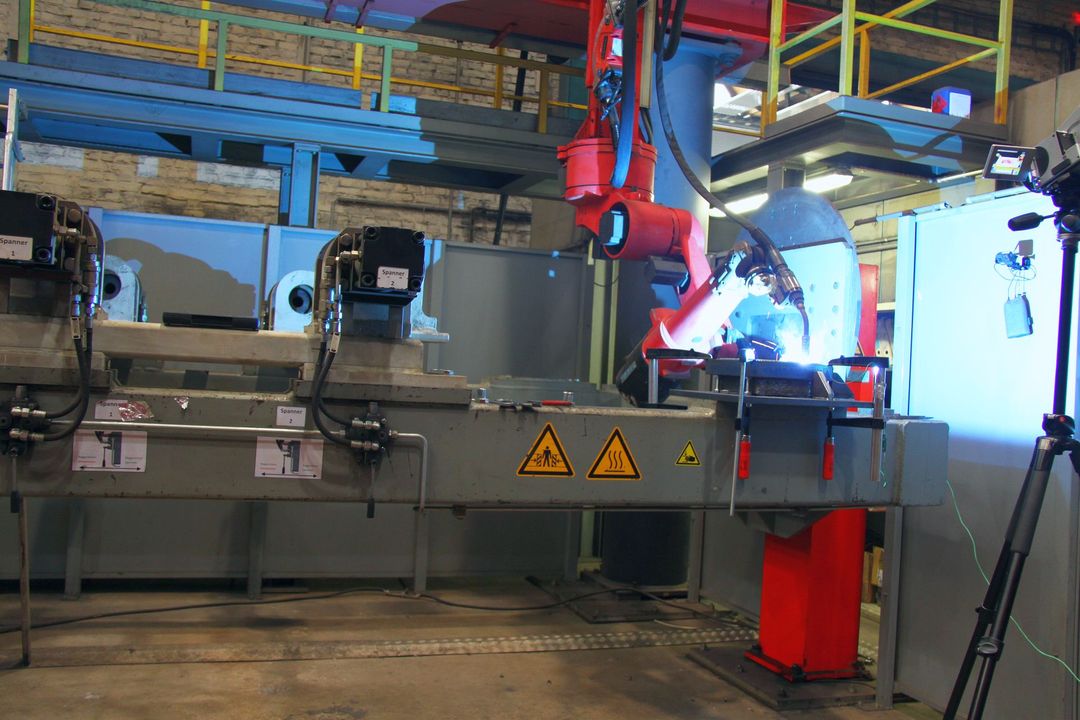3D metal printing: "AFiin" joint project launched
Structural change in Lusatia- this topic is increasingly determining everyday working life in the region. It is a process that must be set in motion with a great deal of commitment and a willingness to innovate - as Ronny Sembol is well aware. He is project manager ofMCR Metal Print, the branch of the LEAG subsidiary that deals with welding processes for additive manufacturing. It's a special day as we speak. The kick-off round marks the start of a groundbreaking cooperation project that is pursuing precisely this goal: Together with the Chair of Joining and Welding Technology (LFT) of the Brandenburg University of Technology Cottbus-Senftenberg (BTU), "AFiin" is entering the race. Behind the name is the project title "Additive Manufacturing of Large-Dimension Machine Assemblies for Short-Term Spare Parts Provision as Part of an Integrated Maintenance Concept". This gives an idea of how complex the topic really is.
The joint project is funded within the framework of the WIR! initiative "Lausitz - Life & Technology " for a period of two years with 450,000 euros from funds of the Federal Ministry of Education and Research (BMBF).
With WAAM to the mechanical engineering service provider of the future
"A strategic development processhas already been taking place at LEAG since 2018 in response to structural change in the region," explains Ronny Sembol. "As a first step, the decision was made at that time to expand business areas close to the market. For us, this meant that around 250 employees now work in LEAG's maintenance workshop with large machine components, opencast mining equipment and rail vehicles. Our goal is to be there in the same size in 2039, except that the product portfolio will be different then." The competencies, the know-how, the large machinery and plant park, the structures - everything is there, he says, it just has to be used. But how? This consideration led to the topic of additive manufacturingin connection with large machine assemblies.
The result of an initial pilot project with BTU Cottbus-Senftenberg lies weightily on the table in the consultation room on this day. A welding node that is welded per WAAM process built up in layers, from bottom to top. "We gave typical requirements that a customer would place on our area to the BTU and thus developed this workpiece in cooperation, which meets our requirements," explains Sembol. In the process, he says, BTU is the scientific and technical partner in the constellation. MCR puts the focus on the user side, he says, in order to raise the project to an economically marketable level. "The issue of procuring spare parts at short notice is a well-known problem for us as a service provider in the sector. Even before the supply bottlenecks of today, the procurement of such special spare parts was often associated with long waiting times. Now the situation has even worsened. Good advice is expensive there. The short-term production of spare parts with small batch sizes is also normally a problem. With our project, we are aiming to reduce overall repair times." Reduced downtime and inventory costs, and thus ultimately increased efficiency, are all becoming increasingly important to companies, he said. "There are delivery times hanging off the back of that, there are employees hanging off the back of that. We're going in there with that focus."
The objective of "AFiin"
"We want to look at the entire process and provide a fully integratedmaintenance approach," says Sembol. "That means the complete damage repair from removal, reporting, spare parts printing, to installation and quality assurance should be done from a single source. What's interesting is that we can also create spare partswithout the need for technical drawings or documentation. This is our benefit, because 3D scanning is possible with us and we have material laboratories at our disposal. We also have access to our own machining and assemblers." That is the ultimate goal, he says - but the aim of the "AFiin" joint project is now first to produce at least one large-scale replacement component as a technology carrier at the end of the two years. "This should then serve as an example that our process works. We want to create confidence in the product in the companies, our future customers."
Beyond this objective, all those involved have their eyes on the benefits for the region itself, which is a particular focus of the project. "We definitely want to maintain and advance the business location of value-creating industry in Schwarze Pumpe. By creating a unique range of services, we are naturally also increasing the potential for keeping jobs in the region and securing them for the future. A diverse partner structure, cooperations and alliances strengthen all sides and create prospects," says Sembol.
Challenges in the research phase
To achieve these goals, there are still some hurdles to overcome. "During the two-year research and development phase, three gaps will have to be closed on the technical and scientific side," explains Sebastian Fritzsche from the Chair of Joining and Welding Technology at BTU Cottbus-Senftenberg.
"The WAAM process, i.e. additive manufacturing by means of automated arc welding, brings with it many advantages: cost-effective plant technology, virtually no installation space restrictions, repair instead of replacement - which significantly reduces costs, broad availability of materials and the possibility of being able to manufacture special material alloysadapted to the application. However, for economical applications, it must be possible to manufacture components quickly. That means printing quickly. For this, the so-called build-up rate is decisive. It is the limiting factor for component size, but also for availability. In the first pilot phase, we printed around 1 kilogram perhour, which is still too low. At this stage, the main focus was also on general feasibility and achieving the quality properties. The build rate is to be increased substantially, at best to 5 to 10 kilograms per hour." That is the first, important point, according to Fritzsche.
"The second construction site is the technological pre- and post-processing of the products. That covers just about everything that relates to the desired digital, fully integratedprocess flow. From technical documentation to mundane things like physical goods in and out. There are still a few issues to be resolved. The last work package," explains the BTU scientist, "deals with the dovetailing of classic mechanical engineering and steel construction with 3D metal printing." There are still few application examples, he says, because the areas have not touched each other much so far. "MCR has the advantage of being able to speak both languages and, as a trailblazer, can build a bridge between the fields."
Advantages of manufacturing using WAAM
Even during the pilot phase, it was clear that the process has many advantages and potential, as it requires less planning and execution than the classic casting process and at the same time is more individualthan joint welding with standard profiles. "For example, it is easier to adapt and change cross-sections and shapes as dictated by stresses, for example," says Fritzsche, bringing up an already successful study of a weld node. "We've managed to more than double the stressability of a simple node - while saving more than 37% of the weight, reducing manufacturing costs and time." In addition, he said, the lifeof the component is increased by the optimized stress profilewithin the part. The manufacturing process is clearly resource-saving, he said, with the CO2 footprint reduced in component production compared to classic processes.
"To achieve this, we need the appropriate manufacturing strategies and processes to be developed to manufacture economically and generate a fast output. With the development of this process chain, we are given the opportunity to think even further, for example, in the form of a digital warehouse for spare parts that we can build. This would allow us to quickly generate good availability for important components that are needed at short notice. That would be a great benefit," Sebastian Fritzsche is certain.
"As a university, of course, we can't implement this on our own. We need industry to work in a targeted manner as research and development, because we need the appropriate application scenarios for the components - the input, the boundary conditions. Where will they be used, what materials are needed? The targeted development of materials in order to drive processes forward and then to work on the design development of the components and finally to transfer the knowledge to companies, that's where we want to go," explains Fritzsche and concludes: "Here, companies get the opportunity to strengthen their innovative capacity and thus also to retain skilled workers and counteract the brain drain. This collaboration between science and businessgenerates and implements new ideas. In this way, we can successfully counter structural changein Lusatia."
Contacts:
Sebastian Fritzsche Chair of Joining and Welding Technology BTU Cottbus - Senftenberg T +49 (0)355 69 4992 s.fritzsche(at)b-tu.de www.b-tu.de/fg-fuegetechnik/
Ronny Sembol MCR Engineering Lausitz T +49 (0)3564 693806 ronny.sembol(at)leag.de www.mcr-engineering.de



